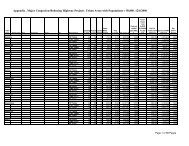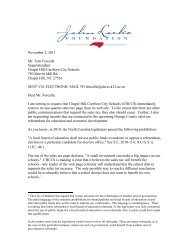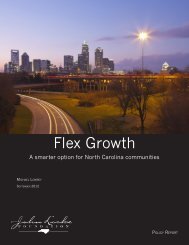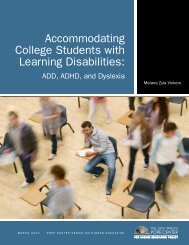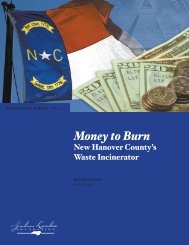Feng Shui Schools - John Locke Foundation
Feng Shui Schools - John Locke Foundation
Feng Shui Schools - John Locke Foundation
Create successful ePaper yourself
Turn your PDF publications into a flip-book with our unique Google optimized e-Paper software.
f e n g s h u i s c h o o l s |<br />
wake County’s unenlightened school building program<br />
Table 4. Pay-As-You-Go Fund: Initial Sources of Revenue<br />
FY 2007<br />
Budget<br />
FY 2008<br />
(Estimated)<br />
Through 2013<br />
(Estimated)<br />
Lottery revenue $9.15 million $9.15 million $54.9 million 19<br />
Redirect a portion of the Hotel/Restaurant Tax revenue $11 million $12.3 million $97.4 million 20<br />
Transfer In – Ad Valorem Tax $0 $16 million $96 million 21<br />
Redirect Community Capital Projects funds $500,000 $500,000 $3 million 22<br />
Redirect Community Use/School Parks funds $0 $1.3 million $7.8 million<br />
Redirect a portion of funds to be used for the future<br />
regional center<br />
$0 $0 $3 million 23<br />
Education Capital Funds: Other Sources $5.6 million $5.9 million $36 million 24<br />
WCPSS staff reduction $0 $1 million $6 million 25<br />
Redirect Exploris/IMAX funding $1 million $1 million $6 million<br />
Redirect Animal Care Control and Adoption Center funds $502,890 $500,000 $3 million 26<br />
Redirect Fire Arms Education Center funds $122,700 $120,000 $736,200 27<br />
Totals $27.9 million $47.8 million $313.8 million<br />
per $100 valuation. 31<br />
A pay-as-you-go fund could draw from<br />
several different revenue streams, small<br />
or large. Lottery revenue is the most<br />
widely known source of capital funding for<br />
schools. The Hotel/Restaurant Tax and Ad<br />
Valorem Tax are two fast-growing sources;<br />
the county could<br />
dedicate a portion<br />
of each for the<br />
pay-as-you-go fund.<br />
Redirecting funds<br />
that the county<br />
plans to use to pay<br />
for smaller projects<br />
and other expenditures<br />
may not produce much funding alone.<br />
But if the school enrollment growth is a crisis,<br />
then the county government and school<br />
system must take every opportunity to redirect<br />
revenue, however small, and dedicate<br />
those funds to school construction.<br />
Of course, a large-scale school construction<br />
program will not be able to have<br />
enough cash on-hand to avoid paying for<br />
schools with some form of debt like bonds<br />
The system should redirect<br />
funds away from lowpriority<br />
projects, reduce<br />
the bureaucracy, reduce<br />
costs, use existing revenue<br />
streams, and implement<br />
alternatives.<br />
or COPs. This should not be used to justify<br />
raising special taxes or fees for a school<br />
construction bond or pay-as-you go fund.<br />
The school system should redirect funds<br />
away from low-priority projects, reduce the<br />
size of the county or school district bureaucracy,<br />
reduce costs, use existing revenue<br />
streams, and implement alternatives (see<br />
Table 5).<br />
Charter <strong>Schools</strong> and Public/Private<br />
Partnerships<br />
In order to increase the number of charter<br />
schools, the state legislature must remove<br />
the charter school cap, and the State Board<br />
of Education would have to approve proposed<br />
schools in Wake County. Making<br />
this reform is not a matter of consensus<br />
but a matter of willingness to demand<br />
legislative action. The consensus is that the<br />
charter school cap should be increased, if<br />
not removed. Fast-growing school systems,<br />
include Wake and Charlotte-Mecklenburg,<br />
could use their considerable influence to<br />
prompt the legislature to increase or remove<br />
the cap, but they have not done so.<br />
J o h n l o c k e f o u n d a t i o n



